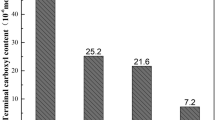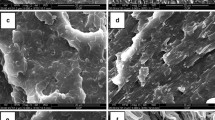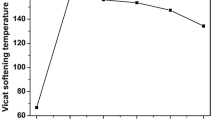Abstract
The effects of the additive amount of a chain extender, with a weight ratio of 3–5 %, on stress-strain curves of poly(lactic acid) (PCL) and poly(butylene succinate-co-l-lactate) (PBSL) polymer blends were examined with a mixing ratio of PLA to PBSL of 70/30. The additive increased the elongation at break, and the strain rate decreased elongation at break.
Access provided by Autonomous University of Puebla. Download conference paper PDF
Similar content being viewed by others
Keywords
3.1 Introduction
Biodegradable plastics and bioplastics are being investigated extensively, and new biodegradable plastics and bioplastics continue to be developed. Poly(lactic acid) (PLA) is a typical biodegradable bioplastic. Many studies have been conducted to develop various industrial products that can be manufactured using biodegradable plastics and bioplastics. However, such applications are currently limited to machine parts that are not subjected to high loading. Because PLA is brittle, its mechanical properties have been improved by polymer blends or natural-fiber reinforcement [1–3]. Because poly(butylene succinate-co-lactate) (PBSL) is a ductile and biodegradable polymer, PLA/PBSL polymer blends have great potential for high strength and toughness [4–7]. In order to increase their compatibility, a chain extender, Joncryl (ADR4370S, BASF), was added.
In this study, we examined the effects of different amounts of the chain extender (crosslinking agent) additive, 3–5 %, on dynamic and static tensile properties, with a mixing ratio of PLA to PBSL of 70/30, using a tensile split Hopkinson bar method and a universal testing machine. After dynamic and static tensile tests, the fracture surfaces of the specimens were observed.
3.2 Experimental Methods
3.2.1 Materials
Polymer blends of PLA and PBSL were prepared using PLA pellet from Nature Works Co. (Ingeo, 3100D) and PBSL pellet from Mitsubishi Chemical Co. (GS Pla® AZ91T). Because PBSL is ductile, there are many possibilities for high mechanical properties (for example, high impact strength) in polymer blends with PLA. Figure 3.1 illustrates the chemical structural formula of PLA and PBSL.
The mixing ratio (mass fraction) of PLA to PBSL was fixed at 70/30. During melt mixing, the chain extender (BASF, Joncryl ADR 4370-S) of the weight ratio of 3, 4, or 5 % was added. After melt mixing in a conventional melt mixer at 190 °C for 20 min, the blend mixtures were press processed using a conventional hot press at 190 °C and 30 MPa for 30 min. Photographs of the cryo-fractured surfaces, taken using a scanning electron microscope (SEM), are shown in Fig. 3.2. Clear two-phase structures were not observed by a scanning electron microscope when the chain extender was added. The chain extender improved the compatibility of PLA and PBSL.
3.2.2 Static Tensile Tests
Quasi-static tensile tests were conducted at a crosshead speed of 0.2 mm/min (strain rate of 0.9 × 10−4 to 2.2 × 10−4 s−1) using a universal testing machine. The strain was calculated by images of the gauge area taken by digital camera. Dimensions of the specimens of static and dynamic tensile tests are shown in Fig. 3.3a.
3.2.3 Dynamic Tensile Tests
At high strain rates, the dynamic properties of the specimens were examined by the tensile split Hopkinson bar test, as shown in Fig. 3.4. The diameters and lengths of input and output bars were 12 and 2000 mm respectively. Strain gages were applied to both sides of the input and output bars at distances of 1750 and 350 mm from the specimen, respectively. The stresses and strains of the specimens [8, 9] were calculated from the strains of the bars measured by strain gages, based on the following equations:
where ε I and ε T are the axial strains in the input bar induced by the incident wave and the axial strain in the output bar induced by the transmitted wave, respectively. E and c 3 are the Young’s modulus and the elastic wave velocity of the input and output bars, respectively. L is the specimen’s thickness. A and A s are the cross-sectional areas of the input/output bars and the specimens. The input and output bars were made of stainless steel (SUS304), and their material constants used in the calculations are listed in Table 3.1. We preserved the specimens in a desiccator at a humidity of 30–40 % until just before use in order to avoid the effects of moisture absorption on the specimens. During the experiments, our laboratory was maintained at a temperature of 25 ± 2 °C and a humidity of 19–54 %. Dimensions of the specimens of dynamic tensile tests are shown in Fig. 3.3b.
3.3 Results and Discussion
The nominal stress-strain curves of the static tensile tests (Fig. 3.5) showed strain softening (work softening), which is defined as the reduction of stress with an increase in strain. When the additive was 5 %, the strain softening was not clear. The maximum stress with the 4 % additive was larger than those of 3 and 5 %. The elongation at break was almost the same among 3, 4 and 5 % additive ratios. At high strain rates, the stress-strain curves of the dynamic tensile tests (Fig. 3.6) did not show strain softening (work softening). The maximum stress and elongation at break were compared (Figs. 3.7 and 3.8); however, the comparisons showed no significant differences. Figure 3.9 shows SEM photographs of the fracture surface. The fracture surface was flat, and no clear elongation was observed. It seems that the elongation of materials decreased at high strain rate.
3.4 Conclusions
Dynamic tensile properties of a bioplastic PLA/PLBS blends were investigated experimentally using a tensile split Hopkinson bar and a universal testing machine. The additive clearly increased elongation at break at low strain rate. However, the additive increased slightly elongation at break. At low strain rate, stress-strain curves showed strain softening.
References
Ikeda, E.: Enhancement of Degradation Rate of Plastics for Suppression of Environmental Pollution by Plastics Waste. J. Soc. Mater. Sci. Jpn. 46(12), 1347–1354 (1997)
Tsukamoto, N., Maruyama, H., Nishida, N.: Biodegradable Plastic Gears. Trans. Jpn. Soc. Mech. Eng. A 60(58), 4318–4324 (1994)
Nishimura, Y., Kato, K., Kobayashi, H.: Development of the Biodegradable String-type Contact Material, Aichi Industrial Technology Institute Report, vol. 1, pp. 242–245 (2002–2012)
Vilay, V., Todo, M., Takayama, T., Jaafar, M., Ahmad, Z., Pasomsouk, K.: Effect of lysine triisocyanate on the mode I fracture behavior of polymer blend of poly(L-lactic acid) and poly(butylene succinate-co-L-lactide). J. Mater. Sci. 44(11), 3006–3009 (2009)
Vilay, V., Mariatti, M., Ahmad, Z., Todo, M., Pasomsouk, K.: Effect of Copolymer on the Mechanical and Thermal Properties and Morphological Behavior of Biodegradable Poly (L-lactic acid) (PLLA) and Poly (Butylene Succinate-co-L-Lactate) (PBSL) Blends. Polymer. Adv. Tech. 22, 1786–1793 (2011)
Kuno, S., Nishida, M., Kawashima, I., Takayama, T., Todo, M.: Dynamic Property Evaluation of PLLA/PBSL Polymer Blends using Compressive and Tensile Split Hopkinson Bar Methods. J. JSEM 12(Special Issue), s198–s204 (2012)
Takeuchi, Y., Nishida, M., Takayama, T., Todo, M.: Effect of chain extender on impact properties of poly (lactic acid) and poly (butylene succinate-co-L-lactate) blends. Proceedings 4th Asian Conference on Mechanics of Functional Materials and Structures, pp. 283–284 (2014)
Gray III, G.T.: Classic split Hopkinson pressure bar testing. In: ASM Handbook, vol. 8, Mechanical Testing and Evaluation, pp. 462–476. ASM, Materials Park (2000)
Chen, W., Song, B.: Split Hopkinson (Kolsky) Bar: Design, Testing and Applications. Springer, New York (2010)
Acknowledgment
Dynamic tensile properties of bioplastic PLA/PLBS blends were investigated experimentally using a tensile split Hopkinson bar and a universal testing machine. At low strain rate, the additive clearly but only slightly increased elongation at break. At low strain rate, stress-strain curves showed strain softening.
Author information
Authors and Affiliations
Corresponding author
Editor information
Editors and Affiliations
Rights and permissions
Copyright information
© 2016 The Society for Experimental Mechanics, Inc.
About this paper
Cite this paper
Nishida, M., Takeuchi, Y., Furuya, S., Takayama, T., Todo, M. (2016). Effects of Chain Extender on Dynamic Properties of PLLA/PBSL Blends. In: Song, B., Lamberson, L., Casem, D., Kimberley, J. (eds) Dynamic Behavior of Materials, Volume 1. Conference Proceedings of the Society for Experimental Mechanics Series. Springer, Cham. https://doi.org/10.1007/978-3-319-22452-7_3
Download citation
DOI: https://doi.org/10.1007/978-3-319-22452-7_3
Publisher Name: Springer, Cham
Print ISBN: 978-3-319-22451-0
Online ISBN: 978-3-319-22452-7
eBook Packages: EngineeringEngineering (R0)













